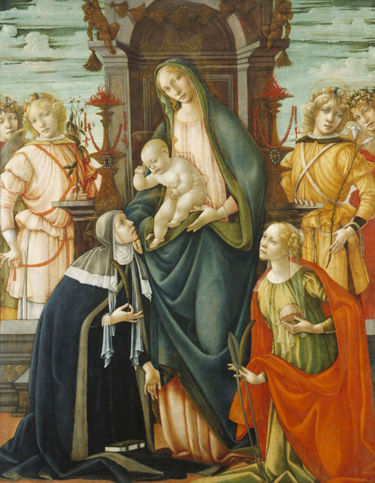Enthroned Madonna and Christ Child with Angels, Saints Paula and Agatha
Enthroned Madonna and Christ Child with Angels, Saints Paula and Agatha is the title of a panel painting in the Samuel H. Kress Collection at the Birmingham Museum of Art. The tempera on poplar panel, 55 3/4" x 43 1/8", was painted about 1500 by Michele Ciampanti. It was loaned to the museum by the Kress Foundation in 1952 and donated formally in 1961.
Ciampanti (active 1470-1510) is a Tuscan artist best known for decorating the vault of the chapel of San Regolo in Lucca and assisting in several other religious commissions in that city. He has recently been identified with the "Stratonice Master" postulated by Bernard Berenson as the author of a number of works of undocumented attribution, including a cassone front, now in the Huntington Library in San Marino, California, depicting the love story of Antiochus and his step-mother, Stratonice. The painter exhibits the influence of Francesco di Giorgio, Sandro Botticelli and Filippino Lippi. It is postulated that he trained first in Siena and spent time in Florence before establishing himself in Lucca.
The subject of the painting is a "Holy Conversation" (sacra conversazione), a motif developed in the early 15th century in Florence. It was most likely commissioned as a devotional painting for a private chapel, possibly by a female patron. The enthroned Mary holds the infant Jesus and is surrounded by youthful angels and two female saints gathered in a unified architectural space under an open sky. The two saints, Agatha and Paula, kneel before the child. The baby Jesus raises his hand in blessing and holds a crown for the latter saint, while a quartet of angels look on from behind a low wall.
The identification of Agatha, on the right, is clear. In addition to a martyr's palm, she holds her amputated breast and the pincers which were used to remove it. The identity of the other female saint, wearing a black cloak and carrying a palm with a book lying at her feet, has been debated. Recent scholarship proposes that she is Paula, founder of the Bethlehem monastery where St Jerome translated the scriptures into the Latin Vulgate.
The angels hold roses and lilies, which symbolize the Virgin's purity (or the annunciation and nativity) and are crowned with floral wreaths. Mary's tall throne is bedecked with two putti holding a garland over her head and with two elaborate candlesticks. The candelabra, which were originally gilded, feature flames of unusual design as well as beaded coral necklaces, which are tokens of protection for infants.
The painting is first documented in the collection of telegraphy pioneer John Watkins Brett in London. It was exhibited at Burlington House in 1877 and in London's New Gallery in 1893-94 as a work of Filippino Lippi. Salomon Reinach attributed the work to "the school of Fra Filippo Lippi" in his Réportoire de Paintures du Moyen Âge et de la Renaissance 1280-1580, published in Paris in 1905. It passed to J. F. Austen, who sold it at Christie's on July 10, 1931 as a Filippo Lippi painting, despite Berenson's contemporary opinion assigning it to his anonymous "Stratonice Master". Kress obtained it from Count Contini-Bonacossi of Florence, Italy in 1954.
References
- "The Samuel H. Kress Collection" (1959) Birmingham: Birmingham Museum of Art
External links
- Italian art at artsbma.org
